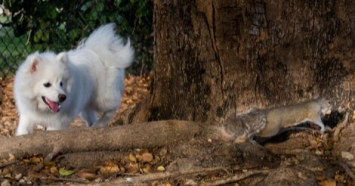
Multiple times a month our hospital sees dogs and cats who’ve experienced violent exchanges with other pets, and have not fared too well in the bargain. This very common occurrence mostly manifests as one or two puncture wounds that may or may not require simple surgical attention, a round of antibiotics, and/or some pain relievers.
These are typically the result of relatively normal inter-dog aggression issues or, less often, the kinds of inter-species altercations you might expect when dogs and cats living in the same household take things a tad too far.
Sometimes, however, the wounds are deep punctures or crushing injuries characteristic of serious attempts to outright kill the patient in question.
In many cases, these can be chalked up to issues surrounding a kind of aggression that we call “inter-dog aggression.” The hallmark of these interactions is that the dogs are exhibiting either offensive or defensive maneuvers that occur within the normal social framework for canine behavior.
While that definition might sound a little murky, I offer it up by way of contrasting it with another aggressive behavior we tend to call "predatory aggression." In these cases, dogs (and cats) tend to attack animals significantly smaller than themselves.
In cases where predatory aggression (and not inter-dog aggression) is assumed, it’s because the attack appears outside the normal context of dog-on-dog violence. In other words, the attacker appears not to have considered his victim a member of his own species.
Predatory aggression is normal in many cases. Indeed, when cats do it to birds and small rodents, for example, we call it "natural." Yet when dogs do it to cats or small dogs, we use words like "vicious," "dangerous," or — more behaviorally accurate and biologically apropos — "predatory."
It’s a cat vs. dog double standard for sure, but it’s a bias we might be forgiven for harboring. Which makes sense given that we're accustomed to being able to control our dogs. They’re bred to keep their wild instincts at bay.
After all, the reason we domesticated many of them in the first place (herding and livestock guardian breeds, in particular) was to eliminate their instinct to kill off our litters, broods, and flocks. But even in the case of hunting dogs, the idea is to attenuate these instincts so we can make the most of them.
Though cats continue to engage in their wild antics by killing mice and such while still enjoying the fruits of their domesticity, dogs don’t get that kind of a pass — not unless we're talking about the relatively few terriers that still engage in owner-sanctioned varmint eradication behaviors.
Consider the following examples by way of illustration:
Example #1:Dogs who have killed cats and other dogs — even in their own yards — have sometimes been deemed "dangerous" by law. In some municipalities (for example, in my neighboring county of Broward County, FL) there’s historically been a one-strike-and-you’re-on-death-row policy. (In recent years, however, this draconian approach has softened substantially to allow dogs a pass if they’re on their own properties.)
Example #2: Even if your dog is out of his property on a leash (as is required by law in most municipalities) and kills a free-roaming cat who crosses his path, your predatory aggressor will almost certainly get a dangerous dog designation if witnesses object to his behavior (particularly if the cat’s owner catches wind of it). In Miami-Dade, where I live, there is a three-strike rule on “dangerous dog” events. Euthanasia is the outcome after the third attack, whether death results or not.
Nonetheless, I’d argue, the killing of certain species by dogs is completely normal and perfectly reasonable –– from their point of view, anyway.
Given what some dog breeds are bred and trained for (think about terrier breeds, sighthounds, coonhounds, etc.), it makes sense that a dog untrained to direct his drives towards the appropriate species might feel driven to kill some smaller, furtively-moving species.
And yet predation is understandably considered an unwanted behavior that needs to be controlled — more so in this highly suburbanized world where pets are family and a beloved two-pound “teacup” puppy can easily be mistaken for a robust rat by an overzealous terrier (I’ve seen it happen).
Because predatory behavior is normal for these domesticated species, predatory aggression becomes a problem to be defined and categorized only when it conflicts with our human desires to maintain a calm household, ensure positive neighborly relations, and pursue environmental harmony, despite our pets’ innate desire to wreak havoc on local wildlife.
These are tough standards for some pets, to be sure, but worth pursuing nonetheless. That’s because nothing’s worse than keeping an otherwise wonderful dog who likes nothing better than to skin the occasional neighborhood cat (while he's still on his leash) in view of every cat-loving neighbor (who are understandably appalled and aggrieved).
But the worst part of predatory aggression is not just that it’s perfectly normal behavior. It’s that in so being, it's also the type of behavior that’s arguably least amenable to treatment.
Because — of course — treatment effectively implies the behavior is abnormal, when it’s not. Misdirected in the context of our current human lifestyles for sure, but pathological? Anomalous? Deviant? Not so much.
I mean, it’s kind of tough to rewire a normal canine psyche just to match your personal human preferences, but there you have it. Proper behavior is always in the eye of the beholder, isn’t it?